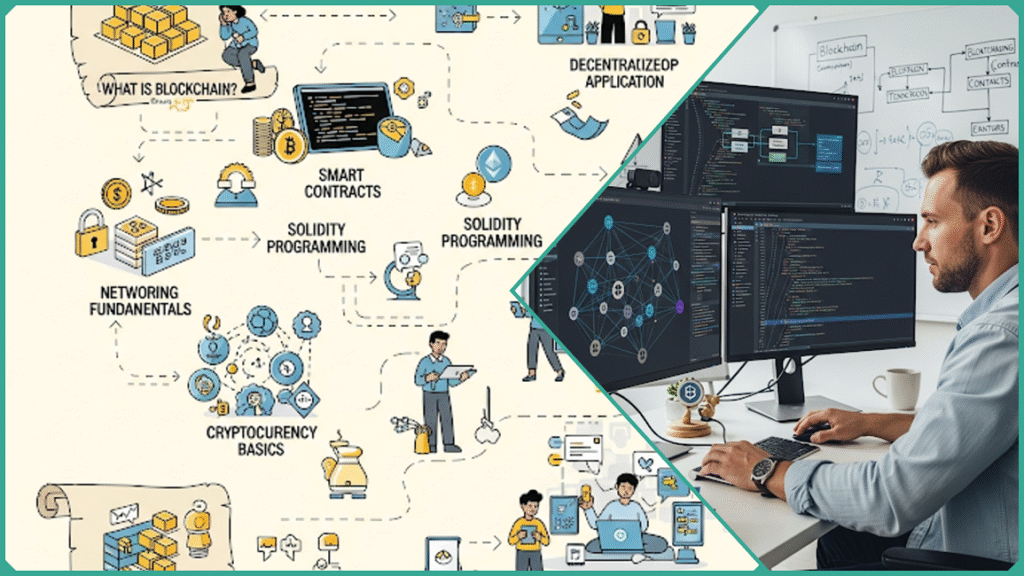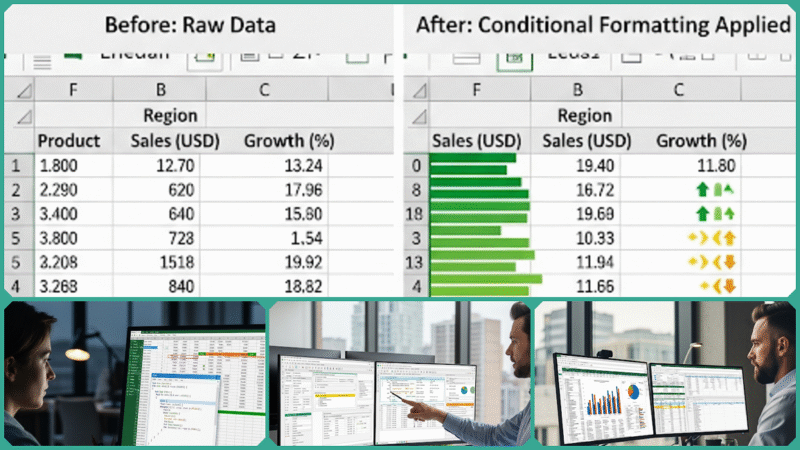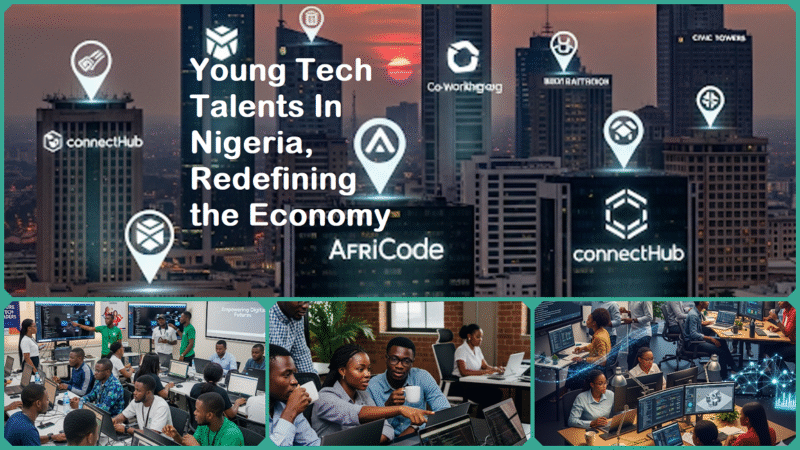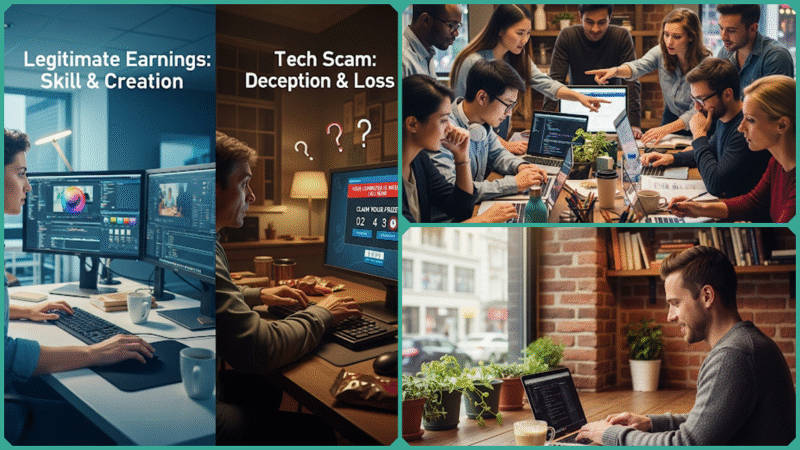How to Become a Blockchain Developer: From Zero to DApp
Estimated reading time: 27 minutes
Blockchain technology stands out as one of the most exciting and transformative innovations of the 21st century, revolutionizing the way data and transactions are handled across various sectors. As a wide range of industries, from finance and healthcare to supply chain management and beyond, increasingly adopt decentralized technologies, the demand for highly skilled and knowledgeable blockchain developers continues to grow at an unprecedented and rapid pace.
This significant surge reflects the increasingly critical role that blockchain technology plays in greatly enhancing security, transparency, and overall efficiency across a wide and diverse range of modern systems and various applications. The growing adoption highlights how blockchain is becoming an essential component in improving the integrity and reliability of these technologies.

Whether you are an absolute beginner with no prior experience, a traditional software developer looking to expand your skills, or a curious professional eager to explore the technical aspects of blockchain technology, this comprehensive and detailed guide is designed to take you from having zero knowledge to building your very own decentralized application (DApp).
By following the steps outlined here, you will learn how to become a proficient blockchain developer and effectively harness this cutting-edge, transformative technology to advance and enhance your career opportunities in this rapidly evolving field.
Why Become a Blockchain Developer?
The blockchain development field presents outstanding career opportunities due to the high demand for skilled experts capable of building decentralized solutions on platforms such as Ethereum, Solana, and Hyperledger.
Industry data shows that blockchain developers in the U.S. earn competitive salaries ranging from approximately $146,000 to $150,000 annually, with experienced professionals commanding even higher compensation. This demand aligns with broader trends in software development, where growth rates are well above average, and blockchain developers are particularly sought after at the forefront of this expansion.
Beyond financial incentives, blockchain development offers a unique and fulfilling career path. It serves as a gateway into an innovative technology domain poised to transform crucial sectors like finance, governance, digital identity, and gaming for decades to come.
The work involves creating secure, transparent applications that empower users by removing intermediaries, which adds a meaningful dimension to the role. This combination of strong economic prospects and the chance to contribute to impactful, cutting-edge technological advancements makes blockchain development a highly attractive and rewarding profession.
Understanding Key Concepts and Technologies in Blockchain Development
To truly understand blockchain development effectively and gain a solid foundation before diving into the actual coding process, it is essential to thoroughly grasp these key foundational concepts and underlying technologies that form the backbone of blockchain systems:
Blockchain
Blockchain is a decentralized digital ledger technology that meticulously records transactions across a vast and distributed network of interconnected computers, commonly referred to as nodes. This system is highly tamper-resistant because individual blocks, which contain detailed transaction data, are securely linked together using cryptographic techniques in a strict chronological sequence to form a permanent and immutable chain.
Each block includes a unique cryptographic hash that references the hash of the previous block, thereby creating a secure and unbreakable connection throughout the entire chain. This structure effectively safeguards the entire history of transactions, making it extremely difficult for any alteration or tampering to occur without detection.
Cryptography
Cryptography plays a crucial role in securing both data and identities within blockchain networks, providing a foundation for trust and safety. Key techniques involved include hashing, which generates unique, fixed-length outputs from any input data, ensuring data integrity and immutability.
Additionally, public and private key cryptography plays a crucial and extensive role in managing digital identities and enabling secure digital signatures. This technology allows users to confidently prove ownership of their digital assets and authenticate transactions in a highly secure manner, ensuring both integrity and trust throughout the process.
Beyond these measures, a wide range of advanced cryptographic proofs and sophisticated protocols are employed extensively to maintain the highest levels of transaction authenticity and to robustly protect user privacy. These mechanisms work together to ensure that all blockchain operations remain fully transparent to authorized parties while simultaneously preserving the confidentiality and security of sensitive information, striking a careful balance between openness and privacy at all times.
Smart Contracts
Smart Contracts are self-executing pieces of code that are deployed on decentralized blockchain platforms such as Ethereum. These contracts are most commonly written in the Solidity programming language, which is specifically designed for this purpose.
Smart contracts automatically enforce predetermined rules and agreements between parties without the need for intermediaries or third-party involvement. This capability allows decentralized applications (DApps) to operate in a secure, transparent, and autonomous manner, ensuring trust and efficiency within the blockchain ecosystem.
Decentralized Applications (DApps)
Decentralized Applications (DApps) operate on blockchain networks in a way that eliminates the need for a central controlling authority or entity. These applications generally rely on smart contracts to handle the backend logic, which are self-executing contracts with the terms directly written into code.
The frontend interfaces of DApps interact seamlessly with the blockchain, allowing users to access the decentralized functionalities. As a result, DApps provide enhanced transparency, robust security, and strong resistance to censorship, making them an innovative alternative to traditional centralized applications.
Consensus Mechanisms
Consensus Mechanisms are essential protocols designed to enable distributed nodes within a network to reach an agreement on the current state of the blockchain. These mechanisms ensure that all participants maintain a consistent and reliable record of transactions. Some of the most common consensus mechanisms in use today include:
- Proof of Work (PoW): In this consensus mechanism, miners compete to solve highly complex mathematical puzzles to add new blocks to the blockchain. This process requires significant computational power, which provides a very high level of security and makes it extremely difficult for malicious actors to alter the blockchain history. However, this security comes at the cost of very high energy consumption, as the mining devices run continuously to solve these puzzles. PoW is famously used by Bitcoin and was previously employed by Ethereum before it transitioned to a different consensus model.
- Proof of Stake (PoS): In this consensus mechanism, validators are required to stake or lock up a certain amount of tokens as collateral in order to earn the rights to validate new blocks on the blockchain. This approach significantly enhances energy efficiency compared to traditional mining methods and allows for faster transaction processing speeds. Popular blockchain platforms that use PoS include Ethereum 2.0, Solana, and Cardano, all of which benefit from its improved scalability and reduced environmental impact.
Tokens and Cryptocurrencies
Tokens and cryptocurrencies are types of digital assets that are securely recorded and maintained on a blockchain ledger. Fungible tokens, such as Ether, serve as digital currency or provide utility within various platforms, allowing them to be interchangeable and used for transactions.
On the other hand, non-fungible tokens (NFTs) represent unique, one-of-a-kind assets that are often used in areas like gaming, digital art, collectibles, and other creative fields. These digital assets play a crucial role in enabling decentralized finance (DeFi) applications and supporting a wide range of innovative blockchain-based economic models and ecosystems.
Together, these fundamental core elements collectively form the essential building blocks of blockchain development, effectively equipping developers with the necessary tools and knowledge to build secure, transparent, and fully decentralized digital solutions that can transform industries and enhance trust in digital transactions.
Technical Skills Required to Become a Blockchain Developer
To become a highly proficient and successful blockchain developer, it is essential to acquire a wide range of technical skills that encompass various domains, including programming languages, cryptographic principles, system architecture design, and the use of specialized development tools.
Below is a comprehensive and detailed breakdown of the key technical skills that are expected to be crucial for blockchain developers in 2025, based on the latest industry insights and emerging trends:
Programming Languages
- Begin by exploring general-purpose programming languages that you might already be familiar with, such as JavaScript, Python, and Java. These languages are widely recognized and frequently employed in the field of blockchain development due to their versatility and extensive libraries supporting blockchain technology. Starting with these languages can provide a solid foundation for understanding and creating blockchain applications.
- Specializes in blockchain-specific programming languages that are tailored to the unique requirements and features of each platform:
- Solidity: Solidity is the primary and most widely used programming language for writing smart contracts on the Ethereum blockchain, as well as other compatible blockchain platforms. It plays a crucial role in the development and deployment of decentralized applications (DApps), enabling programmers to create self-executing contracts with automated, trustless transactions and interactions on the blockchain network.
- Rust, Go, and C++: These programming languages are among the most popular and widely adopted choices for developing newer and more advanced blockchain platforms, including well-known projects such as Solana and Polkadot. They are also extensively used in the development of core blockchain protocols, where performance, security, and efficiency are crucial. Each language offers unique features that make it highly suitable for building scalable and robust blockchain systems.
For frontend or full-stack DApp development, having strong proficiency in JavaScript frameworks such as React or Angular is extremely important. These frameworks enable developers to build sophisticated and dynamic user interfaces that interact seamlessly and efficiently with blockchain networks. Mastery of these tools ensures smooth communication between the frontend application and the underlying blockchain technology, providing users with a responsive and intuitive experience.
Data Structures and Algorithms
- A deep and strong understanding of classical data structures such as linked lists, trees, and graphs, along with fundamental algorithms, plays a crucial role in effectively optimizing blockchain code and enhancing the overall performance of smart contracts. This knowledge allows developers to write more efficient, reliable, and scalable blockchain applications by leveraging the most appropriate data structures and algorithmic techniques.
- Awareness and understanding of blockchain-specialized data structures, such as the widely used Merkle trees, which play a crucial role in the verification of transactions, and the innovative directed acyclic graphs (DAGs), which are employed for efficient and secure data organization within blockchain systems, are highly valuable and increasingly important in the field.
Blockchain Frameworks and Tools
- Gain a comprehensive understanding and become well-acquainted with some of the most popular and widely used Ethereum development environments and tools, such as Truffle, Hardhat, and Remix IDE. These powerful platforms are essential for efficiently writing, rigorously testing, and smoothly deploying smart contracts on the Ethereum blockchain.
- Explore a variety of enterprise blockchain frameworks, including well-known platforms such as Hyperledger Fabric and Corda, which are specifically designed to provide robust and scalable business blockchain solutions. These frameworks offer advanced features tailored to meet the complex needs of enterprises looking to implement secure and efficient blockchain technology for their operations.
- A solid understanding of version control systems such as Git, along with a comprehensive knowledge of testing best practices, including unit testing and integration testing, is essential. This importance is heightened in the context of blockchain development because once the blockchain code is deployed, it becomes immutable and cannot be altered or reversed. Therefore, ensuring code quality and reliability through these practices is critical to avoid costly mistakes and maintain the integrity of the blockchain system.
Cryptography Fundamentals
Gaining a thorough understanding of various cryptographic techniques is foundational and essential, including the following key areas:
- Hashing algorithms: These are essential tools used to ensure data integrity by creating unique, fixed-length digital fingerprints for any given input. Hashing algorithms transform data into a consistent and compact string of characters, allowing verification that the original information has not been altered or tampered with during transmission or storage.
- Public/private key cryptography: This method is used to ensure secure identity verification and the signing of transactions reliably and confidentially. It plays a crucial role in protecting sensitive information by using a pair of keys—one public and one private—to authenticate users and authorize actions securely.
- Digital signatures: Used to verify the authenticity of messages and ensure non-repudiation, meaning that the sender cannot deny having sent the message. This provides a secure way to confirm the origin and integrity of digital communications.
- Advanced concepts such as zero-knowledge proofs play a crucial role in significantly enhancing privacy and building greater trust within blockchain systems, making them more secure and reliable for users. These sophisticated cryptographic techniques ensure that information can be verified without revealing the underlying data, thereby strengthening confidentiality while maintaining transparency in blockchain transactions.
Networking and Distributed Systems
- Develop a thorough understanding of peer-to-peer (P2P) network architectures, which serve as the fundamental framework supporting blockchain decentralized systems. These architectures enable direct communication and data exchange between nodes without relying on a centralized authority, forming the backbone of blockchain technology.
- Know consensus protocols such as Proof of Work (PoW), Proof of Stake (PoS), or even more recent and advanced algorithms to gain a deeper understanding of how network participants come to an agreement on the current state of the blockchain. These consensus mechanisms play a crucial role in maintaining the integrity and security of decentralized networks by ensuring that all nodes validate and agree upon the same version of the blockchain ledger.
- A strong awareness and deep understanding of network security principles, combined with knowledge of potential vulnerabilities, play a crucial role in building more secure and resilient blockchain applications. This comprehensive insight helps developers anticipate threats and implement robust protective measures.
Additional Key Competencies
- Ability to write secure smart contracts with a strong emphasis on avoiding common and uncommon vulnerabilities, thoroughly optimizing gas costs (execution fees) to enhance efficiency, and rigorously ensuring that the contract logic is accurate, reliable, and functions correctly under all intended conditions.
- A comprehensive understanding of various blockchain platforms and their unique ecosystems, including Ethereum, Solana, Hyperledger, and Polkadot, is essential to effectively select the most suitable tools and development paradigms tailored specifically for your projects. This knowledge enables informed decision-making to leverage the strengths and capabilities of each platform, ensuring optimal results and innovation in your blockchain initiatives.
In Summary
A blockchain developer in 2025 should seamlessly combine traditional software development skills with highly specialized blockchain expertise. This includes proficiency in programming languages such as Solidity or Rust, a deep understanding of cryptography principles, insights into distributed systems, and hands-on practical experience with various blockchain development frameworks and tools.
These combined skills are essential to design and build secure, scalable decentralized applications (DApps) and sophisticated smart contracts that can operate efficiently in complex blockchain environments.
Your Learning Path: From Beginner to Blockchain Developer
The learning path you have outlined aligns very well with expert recommendations as well as the common blockchain developer roadmaps anticipated for the year 2025. Below is a comprehensive, detailed, and step-by-step framework that is based on the latest best practices and informed industry insights to help guide your journey:
Step 1: Master the Basics of Blockchain
Begin by gaining a solid and comprehensive foundational understanding of blockchain technology—how it fundamentally works, its essential key components such as blocks, chains, nodes, and cryptographic hashes, as well as its diverse use cases across various industries.
There are numerous free and paid courses readily available on popular online learning platforms such as Coursera, Alison, Udemy, and edX, which offer comprehensive and beginner-friendly introductions to the fundamental concepts of blockchain technology. These courses are designed to help individuals new to the subject gain a solid understanding of how blockchain works, its applications, and its potential impact on various industries.
Additionally, reading core official documentation from Ethereum.org along with other related resources will significantly deepen your grasp of decentralized ledgers, consensus mechanisms, cryptography fundamentals, and the broader blockchain ecosystem. This initial learning step typically takes around 2 to 4 weeks to complete, depending on your learning pace and dedication.
Step 2: Learn Programming Languages
Start with versatile and widely applicable programming languages such as Python or JavaScript, both of which are renowned for their beginner-friendly nature and accessibility. These languages are extensively used and highly valued within the blockchain development community due to their flexibility, ease of learning, and broad range of applications in various blockchain projects and platforms.
Once you have a solid grasp of these foundational languages, shift your focus to learning Solidity, the primary programming language used for writing Ethereum smart contracts and handling decentralized application (DApp) backend logic.
Additionally, you might want to consider exploring other programming languages such as Rust and Go at a later stage, especially if you find yourself developing a keen interest in blockchain platforms like Solana or Polkadot. These languages are widely used and highly regarded within those specific blockchain communities, making them valuable skills to acquire for anyone looking to work on or contribute to projects in those ecosystems.
To reinforce your understanding and improve your coding abilities, engage in regular practice through coding challenges and small-scale projects. This initial learning and practice phase generally lasts between 1 to 3 months, depending on your pace and dedication.
Step 3: Understand Smart Contracts and DApps
Dive deep into the concept of smart contracts—these are self-executing pieces of code that automatically run on the blockchain without the need for intermediaries. Gain a comprehensive understanding of how to write, rigorously test, deploy, and interact with smart contracts, focusing primarily on using the Solidity programming language on various Ethereum testnets.
Explore in depth how decentralized applications (DApps) integrate smart contracts as the core backend logic, enabling them to operate autonomously and securely without intermediaries. These smart contracts execute predefined rules and agreements automatically on a blockchain, ensuring transparency and trustworthiness.
Simultaneously, DApps feature user-friendly frontend interfaces that interact smoothly with these smart contracts, providing users with seamless and intuitive experiences. Together, this combination allows DApps to deliver fully functional applications that maintain decentralization, security, and reliability throughout their operation.
Begin your journey with simple project examples like creating token contracts or building voting applications, and gradually progress toward developing more sophisticated decentralized marketplaces or complex decentralized finance (DeFi) platforms. Plan to dedicate approximately one to two months to master these skills thoroughly.
Step 4: Use Blockchain Development Frameworks
Familiarize yourself thoroughly with essential Ethereum development tools such as Truffle, Hardhat, and Remix IDE. These powerful tools greatly facilitate the entire lifecycle of writing, testing, and deploying smart contracts by providing robust frameworks and environments.
Make it a point to practice deploying your smart contracts on popular Ethereum test networks like Ropsten and Rinkeby, which simulate real blockchain conditions without financial risk. Additionally, invest time in mastering debugging techniques and testing best practices, which include writing comprehensive unit tests and integration tests to ensure your contracts are secure and reliable.
Gaining hands-on experience in this practical development environment will significantly boost your confidence and hone your technical skills. Dedicate approximately 1 to 2 months to this crucial phase of your learning journey.
Step 5: Build Real Projects
Engaging in hands-on development is absolutely essential for gaining a deep understanding of decentralized applications. Begin your journey by cloning existing open-source DApps, which will help you familiarize yourself with their underlying architecture and design principles.
Once comfortable, move forward by designing and building your unique projects, such as NFT marketplaces, decentralized finance (DeFi) protocols, or governance voting applications. Working on real-world projects not only solidifies your learning but also allows you to expand your professional portfolio significantly, making you well-prepared for various industry roles.
Committing to dedicated project work usually spans a period of anywhere from two to three months, and in many cases, it can extend even longer depending on the overall complexity, depth, and scope of the specific projects you decide to take on.
Step 6: Join Blockchain Communities and Contribute
Engage actively with developer forums and communities such as GitHub, Stack Exchange, Ethereum Stack Exchange, as well as blockchain-focused groups on platforms like Discord or Telegram. Contributing regularly to open-source blockchain projects or taking part in various hackathons not only broadens your professional network but also exposes you to a wide variety of codebases and real-world problem-solving scenarios, significantly accelerating your learning process.
Involvement in these communities is an ongoing commitment that should begin as early as possible and continue consistently throughout your entire development journey to maximize growth and opportunities.
Estimated Total Duration
Typically, it takes about 6 to 10 months of consistent and dedicated study, averaging around 3 to 5 hours daily, to achieve proficiency. This timeframe aligns well with established learning roadmaps and expert recommendations designed specifically for beginners as well as individuals transitioning from traditional software development backgrounds. With steady effort over this period, learners can build a strong foundation and gradually advance their skills effectively.
Current Trends and Developments in Blockchain Development
In the year 2025, the field of blockchain development is advancing at an exceptionally rapid pace, with numerous significant trends and groundbreaking innovations actively shaping and transforming the overall technological landscape:
- Layer 2 Scaling Solutions: Innovations such as Optimistic Rollups and zk-Rollups are pivotal in addressing blockchain scalability and transaction cost challenges. These solutions operate on top of existing blockchains like Ethereum to bundle multiple transactions off-chain, reducing on-chain congestion. This leads to faster, cheaper transactions, thereby enhancing the user experience and making decentralized applications (DApps) more accessible and scalable.
- Cross-Chain Interoperability: Protocols like Polkadot and Cosmos are enabling seamless communication and asset transfers between different blockchain networks. This interoperability fosters more integrated blockchain ecosystems, allowing DApps and users to leverage functionalities across multiple chains, breaking down silos and expanding use cases.
- Decentralized Finance (DeFi) Maturation: The DeFi sector continues to expand, moving beyond basic lending and trading to more complex financial services and governance models. This maturation integrates blockchain technology into mainstream finance, offering decentralized alternatives to traditional banking, asset management, and insurance with increased transparency and accessibility.
- NFTs Beyond Digital Art: Non-fungible tokens (NFTs) are broadening their applications beyond digital collectibles and art. They now find use cases in gaming (e.g., play-to-earn models), real estate tokenization, intellectual property management, and virtual worlds within the metaverse. This diversification is driving new economic models and user engagement within blockchain ecosystems.
- Energy Efficiency & Sustainability: Environmental concerns have accelerated the shift from energy-intensive Proof of Work (PoW) to more sustainable consensus mechanisms like Proof of Stake (PoS) and other eco-friendly protocols. This transition significantly reduces blockchain networks’ carbon footprint while maintaining security and decentralization.
- Enhanced Privacy & Security: Advances in cryptographic techniques such as zero-knowledge proofs and multi-party computation are enhancing privacy on blockchains. These technologies allow transaction validation and data sharing without revealing sensitive information, boosting user confidentiality and trust in decentralized systems.
Together, these emerging trends collectively signify an important phase characterized by consolidation, innovation, and much broader adoption of blockchain technology across various industries. As a result, the focus of blockchain development is increasingly shifting toward enhancing scalability, improving interoperability among different platforms, prioritizing sustainability, and maximizing the impact of real-world applications.
This evolution represents a deliberate and focused effort to tackle the existing challenges head-on while simultaneously unlocking the full and vast potential that blockchain solutions offer in practical, impactful, and meaningful ways across various industries and applications.
Actionable Resources to Start Learning Blockchain Development
To begin your journey into blockchain development effectively in the year 2025, it is essential to utilize the most reliable and up-to-date resources available. Below, you will find a carefully curated list of top actionable resources that have been selected based on the latest expert recommendations and current industry trends.
These resources are designed to help you build a strong foundation and advance your skills efficiently in this rapidly evolving field.
Online Course Platforms
- Coursera: Provides a wide range of highly-rated blockchain courses from prestigious universities, including the University at Buffalo’s Blockchain Basics and INSEAD’s Blockchain Revolution. These comprehensive courses expertly blend theoretical knowledge with practical, hands-on projects that cover essential blockchain fundamentals, smart contract development, and platform-specific blockchain technologies. This approach ensures learners gain both conceptual understanding and real-world skills applicable to the blockchain industry.
- Udemy and Alison: These platforms offer a wide range of practical, project-based tutorials that are specifically focused on Solidity and smart contract programming. They provide excellent learning resources not only for beginners who are just starting out but also for those who want to deepen their understanding by building real decentralized applications (DApps). The step-by-step guides and hands-on projects make it easier for learners to grasp complex concepts and apply them in real-world scenarios.
- edX: Offers comprehensive and detailed courses focusing on blockchain architecture as well as its various business applications, making it an excellent choice for learners who want to gain both in-depth technical expertise and a strong understanding of strategic business implications.
- CryptoZombies is a completely free, interactive, and game-based learning platform designed to teach users how to develop Solidity smart contracts. By engaging in the process of building unique crypto-collectibles, learners can gain hands-on experience in a fun and practical way. This platform is especially well-suited for beginners through intermediate users who want to deepen their understanding of blockchain development while enjoying an immersive, gamified educational experience.
- ChainShot: Offers an extensive variety of coding challenges combined with interactive tutorials that are carefully designed to assist users in practicing and enhancing their skills in smart contract programming in a highly effective and efficient manner. These resources are tailored to guide learners through complex concepts step-by-step, ensuring a deeper understanding and practical experience in the field.
Documentation and Tutorials
- Ethereum.org and Soliditylang.org: These websites provide authoritative, comprehensive, and continuously updated documentation along with detailed tutorials specifically designed for Solidity and Ethereum development. They serve as invaluable resources that cater to a wide range of users, from complete beginners who are just starting to learn about blockchain programming to advanced developers seeking in-depth technical guidance and the latest best practices in the rapidly evolving Ethereum ecosystem.
- Hyperledger Fabric Documentation: This is essential reading if you are interested in exploring enterprise-grade or permissioned blockchain frameworks. It provides comprehensive insights and detailed guidance on how to effectively utilize Hyperledger Fabric for building secure, scalable, and robust blockchain solutions tailored to business needs.
Developer Tools
- Truffle Suite, Hardhat, and Remix IDE are some of the most widely adopted and popular development environments used by developers for writing, testing, and deploying smart contracts on Ethereum-compatible blockchains. These tools provide comprehensive frameworks and user-friendly interfaces that streamline the entire smart contract development lifecycle, making it easier to build decentralized applications on Ethereum and other compatible networks.
These advanced tools offer comprehensive simulation and debugging features that significantly enhance development productivity while also strengthening code security. By allowing developers to thoroughly test and debug their applications in a controlled environment, these tools help identify and resolve issues more efficiently, ultimately leading to higher quality software and more secure codebases.
Blockchain Bootcamps and Structured Learning
- Programs such as Utiva and ZeroToMastery offer comprehensive mentor-led bootcamps that blend theoretical knowledge, practical hands-on projects, and strong community support. These programs are designed to provide well-structured and carefully curated learning paths, guiding students from beginner levels all the way through to advanced blockchain developer skills, ensuring a thorough understanding and real-world application.
Additional Credible Blockchain Developer Courses & Certifications
- Udacity Blockchain Developer Nanodegree: This is a comprehensive and in-depth program designed to cover all essential aspects of blockchain technology. It includes foundational concepts of blockchain, practical skills for creating private blockchains, advanced security measures, and the development of decentralized applications, providing learners with a well-rounded understanding and hands-on experience in the blockchain ecosystem.
- University programs: Several leading universities around the world, such as MIT, Harvard, and the National University of Singapore, provide highly specialized blockchain courses and certification programs. These academic offerings delve deeply into a wide range of topics, covering not only the technical foundations of blockchain technology but also exploring important broader aspects such as the development and impact of digital currencies, as well as the ethical considerations and societal implications associated with blockchain adoption and use.
These resources are thoughtfully designed to cater to a wide range of learning preferences and styles—offering everything from self-paced online courses that allow learners to study at their convenience, to interactive coding exercises that provide hands-on experience.
Additionally, comprehensive bootcamps offer intensive, structured training programs, while authoritative documentation serves as a reliable reference to deepen understanding. Together, these diverse resources aim to help learners build a strong foundation and develop practical, real-world skills in blockchain development, starting completely from scratch.
FAQs
How long does it take to become a blockchain developer?
The time to become proficient as a blockchain developer typically ranges from 3 to 12 months of consistent, dedicated learning. This depends largely on your prior programming experience, the intensity of your studies, and how much hands-on practice you get. Beginners might lean toward the longer end, while experienced developers may progress faster.
Do I need a computer science degree to become a blockchain developer?
A formal computer science degree is not mandatory to become a blockchain developer. Many successful developers enter the field through self-study, online courses, coding bootcamps, and practical project experience. While a degree can provide helpful foundational knowledge, hands-on practice and understanding blockchain-specific concepts are what count most.
Which programming language is best for blockchain development?
The best programming language to use largely depends on the specific blockchain platform you are targeting for your development project. Different blockchain platforms often have their own preferred or supported languages, which can greatly influence your choice:
- Solidity is essential for Ethereum smart contract development and widely used for many decentralized applications (DApps).
- Python and JavaScript are valuable for blockchain scripting, interfacing with smart contracts, and developing frontend or backend components.
- Rust has gained popularity for newer blockchains like Solana and Polkadot.
Other programming languages such as Go and C++ are commonly used in the development of core blockchain protocols. These languages play a significant role due to their efficiency and performance capabilities, making them well-suited for building the foundational elements of blockchain technology.
What are decentralized applications (DApps)?
DApps are applications that run on blockchain networks rather than centralized servers. They operate without a central controlling authority by leveraging smart contracts for backend logic and provide transparency, security, and censorship resistance. Examples include decentralized finance (DeFi) platforms, NFT marketplaces, and decentralized games.
Can a traditional software developer switch to blockchain development easily?
Many traditional software developers transition effectively into blockchain development. Existing programming skills, problem-solving experience, and knowledge of software development principles provide a strong foundation. The primary new learning areas include understanding blockchain architecture, smart contracts (especially Solidity), cryptography, and decentralized consensus mechanisms.
In Conclusion
Becoming a blockchain developer is an achievable and rewarding goal—no matter your starting point. By establishing a strong foundation in blockchain principles, mastering key programming languages like Solidity and Rust, and gaining hands-on experience building smart contracts and decentralized applications (DApps), you can carve out a career at the forefront of technological innovation.
The blockchain industry is rapidly evolving, with increasing demand for skilled developers who can build secure, scalable, and transparent solutions across finance, governance, gaming, and many other sectors. This makes now the perfect time to start your blockchain journey.
To succeed, stay curious, practice regularly, and actively participate in blockchain communities and open-source projects. Immersing yourself in this dynamic ecosystem will accelerate your growth from a beginner to a confident blockchain developer capable of creating impactful decentralized applications that could transform industries.
Begin your exciting and transformative learning journey today and become an essential and integral part of the rapidly evolving and ever-changing future that is driven, powered, and shaped by the innovative and groundbreaking blockchain technology that is revolutionizing industries worldwide.
Discover more from Skill to Grow
Subscribe to get the latest posts sent to your email.






